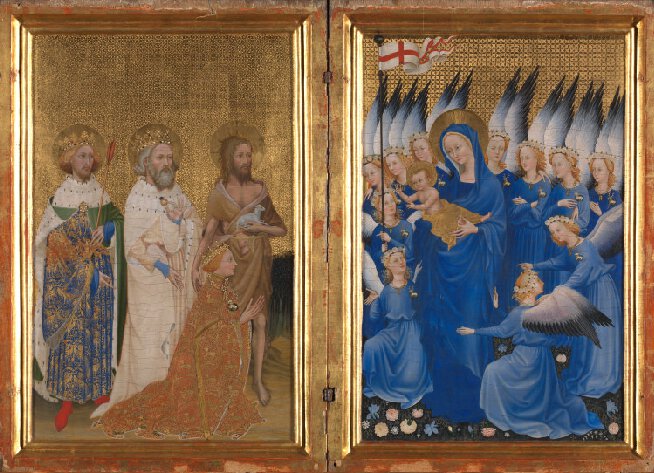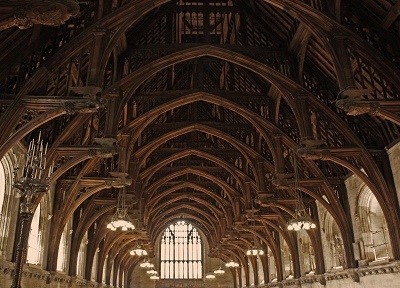Hammer beam angel roof of Westminster Hall
Westminster Hall is part of the Palace of Westminster and is the oldest building on the Parliamentary estate. A listed Grade I building, it was built for William II in 1097-99 and at that time was the largest Hall in England measuring 73m x 20m in plan.
Richard II's reign was a turbulent period in English politics with the Peasants' Revolt early in the reign and Richard himself deposed in 1399. Yet, the period was a watershed in English art and letters: it saw impressive developments in manuscript illumination and perpendicular architecture as well as the emergence of the greatest vernacular literature in Europe.
The hammer-beam roof was commissioned by Richard II in 1393 and is the largest medieval timber roof in Northern Europe.
The Hall has been subject to several major restoration works since the 1740s. These include the replacement of the lead roof with slate and steel supports added to the roof timbers.
The Hall survived both the fire that destroyed the House of Lords and House of Commons in 1834 and bomb attacks in the Second World War.

The Wilton Diptych
The Wilton Diptych, now to be found in the National Gallery takes its name from Wilton House, near Salisbury, Wiltshire, the seat of the Earls of Pembroke where it was housed between 1705 and 1929. The name of the artist and the place where it was made are unknown.
It has been suggested that the painter came from Italy or Bohemia, but it is probable that the diptych - a painting or other representation composed of two hinged leaves which close like a book - was made on behalf of Richard II himself and that it was painted in England or northern France around the time of Richard's second marriage in 1396.
Such surviving panel paintings from northern Europe dating from the late fourteenth century are very rare.
The 'Wilton Diptych' was painted as a portable altarpiece for the private devotion of King Richard II, who ruled England from 1377 to 1399. The diptych is thought to have been made in the last five years of his reign.
The panels of the Wilton Diptych are made of North European oak, but have been transformed by immaculate painting and gilding, into a heavenly vision. On the inside, Richard II is presented by three saints to the Virgin and Child and a company of eleven angels. Nearest to Richard is his patron saint John the Baptist. Behind are Saint Edward the Confessor and Saint Edmund, earlier English kings who came to be venerated as saints.
The outside bears Richard's arms and his personal emblem of a white hart chained with a crown around its neck.
about our lecturer:
Mark Cottle is a native of the Scilly Isles and a graduate of Birmingham University, where he qualified in Medieval History. As a NADFAS affiliated speaker and in other roles, Mark has spent over 20 years as a lecturer in further and higher education, pursuing his crusade against the ever-increasing decline of medieval history in formal education.
His lecture list is dominated by Anglo-Saxon, medieval and Tudor history and art history, though oddly his most popular talk is on Shackleton’s Endurance expedition of 1914 through the photographic record that survived.
Mark runs two companies dedicated to halting the decline of interest in medieval history and organizes courses on this subject and others at Buckfast Abbey.
Read more at Mark's Exploring History website

